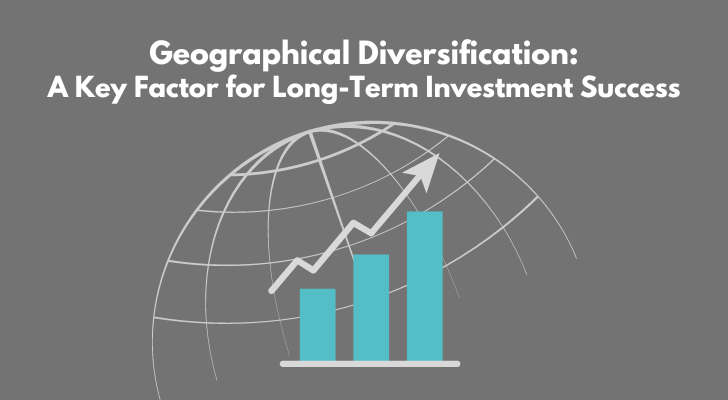Geographical diversification means spreading your investments across different markets and regions to reduce risk and maximize returns. Geographical diversification is a key factor for long-term investment success, as it provides exposure to a range of economies and industries while reducing dependence on any one region or market.

Did You Know?
- Average Stock Market Returns: Historically, the S&P 500 has offered an average annual return of about 10% before inflation.
- Long-Term Bonds: Over the past 30 years, long-term government bonds have averaged returns of approximately 5-6% per year.
- Real Estate Appreciation: On average, real estate in the United States has appreciated about 3-4% per year over the long term, varying significantly by location.
- Gold as an Investment: Over the last 50 years, gold has averaged an annual return of approximately 8%.
- Retirement Savings: The average retirement account balance in the U.S. reached about $106,000 in 2021.
- Investor Behavior: About 55% of Americans own stocks, either directly or as part of a fund.
- Index Funds Growth: Index funds have seen significant growth, with assets under management in S&P 500 index funds exceeding $4 trillion by 2020.
Why Diversification Matters
Diversification is a must for any investor. By holding a variety of investments, you can minimize your risk and maximize your potential for return.
Geographic diversification is particularly beneficial. Because by investing in a variety of geographic regions, you can mitigate the risks associated with any one particular region. For example, if there is an economic downturn in Europe, your investments in other regions may help offset any losses.
This also means that you take advantage of different growth opportunities around the world. While one region may be experiencing slower growth, another may be booming. Cover a variety of regions and you can capture some of this global growth.
Ways to achieve geographic diversification in your portfolio include;
- Invest in international mutual funds or ETFs that provide exposure to a variety of countries and regions.
- Invest directly in foreign stocks or bonds.
So not only by spreading your bets across a number of different asset classes but also across a number of geographic regions, you can minimize your risk and maximize your chances for success.
Political Risks and Geographical Diversification
So you know roughly how geographical diversification can lead to investment success. But another thing I should mention is that Geographical diversification can also help to protect your investments from political risks.
For example, if there is instability in one country, your investments in other countries may not be affected. This diversification can therefore provide some level of protection against geopolitical risks.

Especially in the current climate, we never know which part of the world will go badly economically. The global economy is unpredictable and volatile, with economic booms and busts occurring across multiple countries around the world.
This has left many businesses struggling to remain competitive and stable while they deal with shifting market conditions. Political instability can certainly affect a country's economic prospects, along with other factors such as natural disasters that are beyond our control.
As such, it is difficult to predict when or where an area might experience a sudden downturn in its economic situation - this uncertainty can make it hard for investors to plan ahead and prepare for potential challenges in their finances.
Did You Know?
- Dividend Reinvestment: Dividend reinvestment contributes significantly to the long-term growth of stock investments, accounting for over 40% of the S&P 500's total returns over the last 50 years.
- 401(k) Participation: Over 60 million Americans actively participate in 401(k) plans, with an average account balance of around $104,000.
- IRA Investments: Individual Retirement Accounts (IRAs) hold over $9 trillion in assets, with traditional IRAs being the most popular type.
- Emerging Markets: Over the past decade, emerging market equities have returned an average of about 8% per year.
- Tech Stocks Performance: Technology stocks have significantly outperformed the broader market over the past decade, with some companies achieving annual growth rates of over 20%.
- Long-Term Investment in Education: Investments in higher education typically yield a 10-15% return over a lifetime through higher earnings.
- Healthcare Sector Growth: The healthcare sector has seen an average annual return of approximately 13% over the past 10 years.
How to Achieve Geographical Diversification
Here are the ways to achieve geographical diversification in your investment portfolio.
Global Index Fund
Investing in a global index fund is an effective way to gain exposure to different economies and markets around the world. These funds typically track major indices such as the S&P 500 or Dow Jones Industrial Average, while also including companies from a variety of countries, thus allowing investors to benefit from growth and performance across many geographic regions at once.
This type of investment can help diversify portfolios and protect against the risk associated with investing solely in one country or region. Additionally, due to their low-cost nature, these funds are often ideal for long-term investments since fees related to buying and selling stocks can be greatly reduced.

Foreign Stocks or Mutual Funds
Investing directly in foreign stocks or mutual funds can be a great way to diversify and expand one's portfolio. It is now easier than ever to do this through online brokerages, which allow users to purchase shares of companies based outside the United States.
This can help investors access potentially higher returns while also reducing risk by introducing more assets into the mix. With online brokers offering low fees and straightforward processes, it has never been simpler for individual investors to access international markets with ease and confidence.
Whichever method you choose, it's important to make sure that you're diversified across a broad range of countries and regions in order to minimize your overall risk.
Did You Know?
- Sustainability and ESG Investing: Assets in sustainable and ESG (Environmental, Social, Governance) funds have grown to exceed $1 trillion globally, with strong performance relative to non-ESG funds.
- Cryptocurrency Volatility: Despite its volatility, Bitcoin has seen an average annual return of over 200% since its inception, though with significant year-to-year fluctuations.
- Private Equity: Private equity funds have delivered an average annual return of about 11.4% over the past decade.
- Venture Capital: Venture capital investments have averaged returns of approximately 13.3% over the past 15 years.
- Inflation Impact: The average annual inflation rate in the U.S. has been about 2-3%, which investors need to outpace to gain real returns.
- Millennial Investors: About 66% of millennials are interested in sustainable investments, and this demographic is more likely to invest in ESG funds than older generations.
Geographical Diversification: A Key Factor for Investment Success - Wrapping Up
So to sum up, geographical diversification is an essential part of any long-term investment strategy. By investing in a variety of different markets and countries, investors can spread their risk across multiple geographies and reduce the overall volatility associated with their investments.
This type of diversification also allows for more flexibility when it comes to managing portfolios as changes in one market may be offset by gains or losses in another market.
Geographical diversification ensures that no single area has too much influence over an investor's portfolio while still providing potential opportunities to obtain higher returns than if only one region was targeted.
